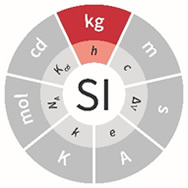Mass (the kilogram, kg)
SI base unit of mass
Current Definition
 The kilogram, symbol kg, is the SI unit of mass. It is defined by taking the fixed numerical value of the Planck constant h to be 6.626 070 15 x10−34 when expressed in the unit J⋅s, which is equal to kg⋅m2⋅s−1, where the metre and the second are defined in terms of c and ΔvCs.
The kilogram, symbol kg, is the SI unit of mass. It is defined by taking the fixed numerical value of the Planck constant h to be 6.626 070 15 x10−34 when expressed in the unit J⋅s, which is equal to kg⋅m2⋅s−1, where the metre and the second are defined in terms of c and ΔvCs.
History
| Year | Definition of the kilogram |
|---|---|
| 1791 | The unit of the kilogram originated from a physical constant – the density of water. The kilogram was initially defined as the mass of one litre (cubic decimetre) of distilled water at its melting point. |
| 1795 | The definition of kilogram was amended by changing the reference conditions of water to the temperature of maximum density at atmospheric pressure of distilled water (about 4°C). |
| 1799 | The kilogram definition was changed again by adopting a material artefact known as the kilogram of the archives, the KA, which was a cylinder of platinum. The KA was delivered in June 1799 to the National Archives of France, which still maintains custody. The KA was the mass standard of France for nearly one hundred year. |
| 1889 | The unit of kilogram was redefined based on the mass of the international prototype of the kilogram (IPK or the Big K). The IPK is a piece of platinum-iridium alloy kept in BIPM in Paris. Copies of the IPK were despatched to signatories of the Metre Convention as their national mass standards. Hong Kong received the 75th copy of the IPK in 1993. |
| 2019 | The kilogram was defined by fixing the numerical value of the Planck constant h to 6.62607015 x 10-34 |
Reference
- The International System of Units (SI) – Base Unit
- The ninth SI Brochure